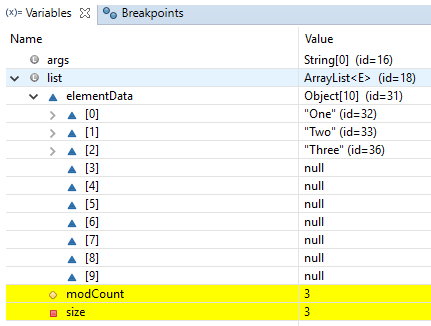ArrayList – Internal implementation
-
The underlying data structure is ResizableArray or Growable Array
-
Duplicates are allowed
-
Insertion order is preserved
-
Heterogeneous (different datatypes) Objects are allowed
-
Null is insertion is allowed
-
ArrayList implements Serializable, Clonable & RandomAccess
-
Except TreeSet & TreeMap Everywhere Heterogeneous Objects are allowed
public class ArrayListDemo {
public static void main(String[] args) {
ArrayList l = new ArrayList<>();
l.add("A");
l.add(10);
l.add("A");
l.add(null);
System.out.println(l); // [A, 10, A, null]
l.remove(2);
System.out.println(l); // [A, 10, null]
l.add(2, "M");
System.out.println(l); // [A, 10, M, null]
l.add("N");
System.out.println(l); // [A, 10, M, null, N]
}
}
Internal implementation
1.ArrayList grows dynamically as the elements are added to it. Internally an ArrayList uses an Object[] Array.
private transient Object[] elementData;
2.When an object of ArrayList is created without initial capacity, the default constructor of the ArrayList class is invoked. default capacity of 10 is assigned at a time of empty initialization of ArrayList.
public ArrayList() {
this(10);
}
3.In the add(Object), the capacity of the ArrayList will be checked before adding a new element
public boolean add(E e) {
ensureCapacity(size + 1); // Increments modCount!!
elementData[size++] = e;
return true;
}
public void ensureCapacity(int minCapacity) {
if (minCapacity > oldCapacity) {
int newCapacity = (oldCapacity * 3) / 2 + 1;
elementData = Arrays.copyOf(elementData, newCapacity);
}
}
4.If size of the filled elements is greater than the maximum size of the array then increase the size of array by using below formulae, Then elements will copy to old Array to New Array
Till Java 6 : int newCapacity = (oldCapacity * 3)/2 + 1;
From Java 7 : int newCapacity = oldCapacity + (oldCapacity >> 1); (50% of old)
5.If elements are adding in the middle index, Array Elements will shifted to Right
-
Adding NOT good
o(n) -
Get(by index) Good
o(1)
Interviewer : What is the runtime performance of the get() method in ArrayList
, where n represents the number of elements ?
get() ,set() , size() operations run in constant time i.e O(1)
add() operation runs in amortized constant time , i.e adding n elements require
O(n) time.
public class ArrayListDemo {
public static void main(String[] args) {
/*1.ArrayList With Defalut Capacity 10 is created
* & assiged values as null
* elemetntdata = [null, null, null,....10 Objects]
* modcount = 0, no modifications performed
* size=0
* */
ArrayList<String> list = new ArrayList<>();
/*adding first element, add("one");
* elementdata=["one,null, null, null ....."]
* modcount = 1
* Size = 1 *
* */
list.add("One");
list.add("Two");
list.add("Three");
System.out.println(list);
}
}

-
Usually we use collections to hold & transfer objects from one location to another location. To provide support for this requirement every collection class implements Serializable & Clonable interfaces
-
ArrayList and Vector classes implements RandomAccess interface, so that any random element we can access with same speed. RandomAccess is a marker interface & doesn’t have any methods
-
Insertion/Deletion is middle ArrayList is the Worst choice. For retrieval Best Choice
-
In every collection class toString() is overridden to print data readable format [ob1, ob2, ob3]